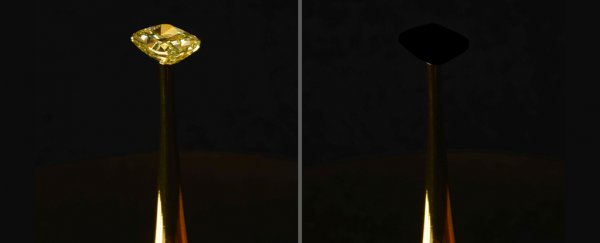You might think you already know black – even super-black Vantablack, previously the blackest material known to science – but researchers just came up with a material that takes black to a new level of blackness.
The new, as-yet-unnamed ultra-black material is made from vertically aligned carbon nanotubes (CNTs), microscopic carbon strings that are a little like a fuzzy forest of tiny trees, according to the team behind the project.
And here's the rub – this CNT material can absorb more than 99.995 percent of incoming light, beating the 99.96 percent that Vantablack is able to absorb.
"In other words, it reflected 10 times less light than all other superblack materials, including Vantablack," explains an MIT release.
Like some of the best scientific discoveries, this record-setting black stuff was discovered by accident.
The researchers were looking at ways to grow CNTs on electrically conductive materials like aluminium, and it was during these experiments that they noticed the blackness of the materials they were growing on specially treated aluminium foil.
"I remember noticing how black it was before growing carbon nanotubes on it, and then after growth, it looked even darker," says mechanical engineer Kehang Cui, from Shanghai Jiao Tong University in China. "So I thought I should measure the optical reflectance of the sample."
That's when the ultra-powerful light absorption properties were recorded – from every possible angle, the material soaked up virtually all the light directed at it.
What's not clear is why the material is like this. It might be the way that the etched aluminium, on which the oxide layer is removed, combines with the carbon nanotubes in some way, but more research is going to be needed to know for sure.
In the meantime, the new record-setting black is on show at an art exhibition in New York called The Redemption of Vanity.
MIT artist-in-residence Diemut Strebe has worked with the researchers to coat a 16.78-carat natural yellow diamond from LJ West Diamonds, estimated to be worth $2 million, in the ultrablack material.
What should be a bright, sparkling, highly reflective gem ends up a lightless void.
"Because of the extremely high light absorptive qualities of the CNTs, any object, in this case a large diamond coated with CNTs, becomes a kind of black hole absent of shadows," says Strebe.
"The unification of extreme opposites in one object and the particular aesthetic features of the CNTs caught my imagination for this art project."
Of course the potential uses for super-black materials go far beyond art exhibits. Removing light and glare is essential in optical instruments such as cameras and telescopes, and it's possible that the new material could be used to keep light away from space telescopes.
As for how long it's going to be before we see a material that's even blacker than the ones we have at the moment, the researchers are philosophical.
"I think the blackest black is a constantly moving target," says aeronautics and astronautics professor Brian Wardle, from the Massachusetts Institute of Technology.
"Someone will find a blacker material, and eventually we'll understand all the underlying mechanisms, and will be able to properly engineer the ultimate black."
The research has been published in ACS Applied Materials & Interfaces.
